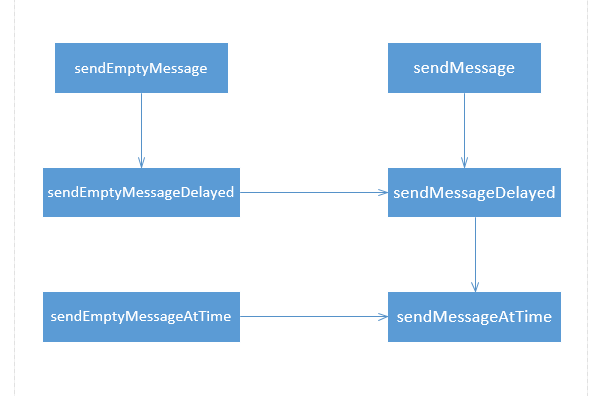Handler是Android中引入的一种让开发者参与处理线程中消息循环的机制。我们在使用Handler的时候与Message打交道最多,Message是Hanlder机制向开发人员暴露出来的相关类,可以通过Message类完成大部分操作Handler的功能。
说Handler之前先看看Looper。
MessageQueue 是存放Message的消息队列,只是一个容器,而Looper 则是让MessageQueue循环动起来。
默认下创建一个线程,线程里面是没有消息队列的,如果想用消息队列MessageQueue,就需要通过Looper进行绑定。下面是一个简单的例子:
class LooperThread extends Thread {
public Handler mHandler;
public void run() {
Looper.prepare();
mHandler = new Handler() {
public void handleMessage(Message msg) {
// process incoming messages here
}
};
Looper.loop();
}
}
可以看见Thread通过Looper.prepare() 和 Looper.loop()两个静态方法运行。
从源码里看 Looper的构造函数是private,则说明Looper不能再外部实例化。就可以猜测到Looper和Thread是一一对应的。
private Looper(boolean quitAllowed) {
//实例化MessageQueue。
mQueue = new MessageQueue(quitAllowed);
//获取当前线程。
mThread = Thread.currentThread();
}
看一下Looper.prepare()方法:
/** Initialize the current thread as a looper.
* This gives you a chance to create handlers that then reference
* this looper, before actually starting the loop. Be sure to call
* {@link #loop()} after calling this method, and end it by calling
* {@link #quit()}.
*/
public static void prepare() {
prepare(true);
}
private static void prepare(boolean quitAllowed) {
if (sThreadLocal.get() != null) {
throw new RuntimeException("Only one Looper may be created per thread");
}
sThreadLocal.set(new Looper(quitAllowed));
}
在Looper.prepare() 时候将Looper存起来,存在一个叫ThreadLocal
// sThreadLocal.get() will return null unless you've called prepare().
static final ThreadLocal sThreadLocal = new ThreadLocal();
Looper.prepare()调用完之后Looper就准备好了,接着就可以通过Looper.loop() 让MessageQueue循环动起来。loop()的源码:
/**
* Run the message queue in this thread. Be sure to call
* {@link #quit()} to end the loop.
*/
public static void loop() {
final Looper me = myLooper();
if (me == null) {
throw new RuntimeException("No Looper; Looper.prepare() wasn't called on this thread.");
}
//获取当前线程的MessageQueue。
final MessageQueue queue = me.mQueue;
// Make sure the identity of this thread is that of the local process,
// and keep track of what that identity token actually is.
Binder.clearCallingIdentity();
final long ident = Binder.clearCallingIdentity();
for (;;) {
//获取MessageQuene消息队列的消息.
Message msg = queue.next(); // might block
//如果消息队列没有消息,则return,即阻塞在这里,等待获取Message。
if (msg == null) {
// No message indicates that the message queue is quitting.
return;
}
// This must be in a local variable, in case a UI event sets the logger
Printer logging = me.mLogging;
if (logging != null) {
logging.println(">>>>> Dispatching to " + msg.target + " " +
msg.callback + ": " + msg.what);
}
// msg.target 是一个Handler,这个意思是让改Message关联的Handler通过dispatchMessage()处理Message。
msg.target.dispatchMessage(msg);
if (logging != null) {
logging.println("<<<<< Finished to " + msg.target + " " + msg.callback);
}
// Make sure that during the course of dispatching the
// identity of the thread wasn't corrupted.
final long newIdent = Binder.clearCallingIdentity();
if (ident != newIdent) {
Log.wtf(TAG, "Thread identity changed from 0x"
+ Long.toHexString(ident) + " to 0x"
+ Long.toHexString(newIdent) + " while dispatching to "
+ msg.target.getClass().getName() + " "
+ msg.callback + " what=" + msg.what);
}
msg.recycleUnchecked();
}
}
Handler 构造函数
Handler 是暴露给外部调用者使用,Handler有多个构造函数.
public Handler()
public Handler(Callback callback)
public Handler(Looper looper)
-
public Handler(Looper looper, Callback callback)
第1,2个构造函数是没有传Looper的,他将获取该线程的Looper和MessageQueue消息队列.
public Handler(Callback callback, boolean async) {
if (FIND_POTENTIAL_LEAKS) {
final Class klass = getClass();
if ((klass.isAnonymousClass() || klass.isMemberClass() || klass.isLocalClass()) &&
(klass.getModifiers() & Modifier.STATIC) == 0) {
Log.w(TAG, "The following Handler class should be static or leaks might occur: " +
klass.getCanonicalName());
}
}
mLooper = Looper.myLooper();
if (mLooper == null) {
throw new RuntimeException(
"Can't create handler inside thread that has not called Looper.prepare()");
}
mQueue = mLooper.mQueue;
mCallback = callback;
mAsynchronous = async;
}
第3,4构造函数有传Looper,这两个构造函数会将该Looper保存到名为mLooper的成员字段中
public Handler(Looper looper, Callback callback, boolean async) {
mLooper = looper;
mQueue = looper.mQueue;
mCallback = callback;
mAsynchronous = async;
}
第2,4构造函数还传入一个Callback回调函数.是一个接口
public interface Callback {
public boolean handleMessage(Message msg);
}
Handler.Callback是用来处理Message的一种手段,在构造函数中传递Callback,则可以处理Message,如果返回的是true,则不再往下执行,起到拦截的效果。如果构造函数没有传递Callback,则应在Handler中重写handleMessage方法。
sendMessage 发送消息
在线程中可以通过sendMessage XXX方式往消息队列中添加Message。
- sendMessage(Message msg):
- sendMessageDelayed(Message msg, long delayMillis):
- sendMessageAtTime(Message msg, long uptimeMillis) :
- sendEmptyMessage(int what)
- sendEmptyMessageDelayed(int what, long delayMillis)
- sendEmptyMessageAtTime(int what, long uptimeMillis) :
通过看Handler源码可以知道,最终都是调用sendMessageAtTime方法。而在sendMessageAtTime中通过enqueueMessage方法将Message放入消息队列中。
public boolean sendMessageAtTime(Message msg, long uptimeMillis) {
MessageQueue queue = mQueue;
if (queue == null) {
RuntimeException e = new RuntimeException(
this + " sendMessageAtTime() called with no mQueue");
Log.w("Looper", e.getMessage(), e);
return false;
}
return enqueueMessage(queue, msg, uptimeMillis);
}
private boolean enqueueMessage(MessageQueue queue, Message msg, long uptimeMillis) {
//将Message的target绑定为当前的Handler
msg.target = this;
if (mAsynchronous) {
msg.setAsynchronous(true);
}
return queue.enqueueMessage(msg, uptimeMillis);
}
msg.target = this : 将Message的target绑定为当前的Handler .
-
queue.enqueueMessage(msg, uptimeMillis): queue 是当前Handler的消息队列MessageQueue.通过queue.enqueueMessage将Message放入消息队列。
post 方式发送消息
post(Runnable r)
postAtTime(Runnable r, long uptimeMillis)
postAtTime(Runnable r, Object token, long uptimeMillis)
-
postDelayed(Runnable r, long delayMillis)
其中post 和 postDelayed 最后还是调用sendMessageDelayed方法。postAtTime最后调用sendMessageAtTime方法,最终的调用和sendMessage一样。
public final boolean post(Runnable r){
return sendMessageDelayed(getPostMessage(r), 0);
}
可以看到内部调用了getPostMessage方法,该方法传入一个Runnable对象,得到一个Message对象,getPostMessage的源码如下:
private static Message getPostMessage(Runnable r) {
Message m = Message.obtain();
m.callback = r;
return m;
}
通过上面的代码我们可以看到在getPostMessage方法中,我们创建了一个Message对象,并将传入的Runnable对象赋值给Message的callback成员字段,然后返回该Message,然后在post方法中该携带有Runnable信息的Message传入到sendMessageDelayed方法中。
dispatchMessage
在Looper中可以知道在Looper.loop()中最后通过msg.target.dispatchMessage(msg)来处理Message。
看一下dispatchMessage的源码:
/**
* Handle system messages here.
*/
public void dispatchMessage(Message msg) {
if (msg.callback != null) {
handleCallback(msg);
} else {
if (mCallback != null) {
if (mCallback.handleMessage(msg)) {
return;
}
}
handleMessage(msg);
}
}
post方式
这其中,首先判断msg.callback是否为空,msg.callback是一个Runnable对象,如果不为null,则说明这是通过post的方式发送消息。内部通过 handleCallback(msg)方式执行。
private static void handleCallback(Message message) {
message.callback.run();
}
这样就会执行message.callback.run(),也就是Runnable的run方法。
sendMessage方法
如果msg.callback返回有null,则是通过sendMessageXXX方式发送消息。
这里面接着判断mCallback是否有值,即构造函数中是否传Callback,如果有就会调用Callback中的handleMessage,如果没有就会调用Handler中的handleMessage。
总结
综合上述:handler 提供3中方式处理消息,首先先判断是否是post方式,先尝试Post的Runnable的run方法。
接着尝试构造函数的handleMessage方法,最后调用handler的handleMessage方法。
